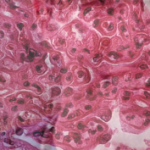Osteoporosis Update
Next, Abby Abelson, MD, chair of the Department of Rheumatic and Immunologic Diseases at the Cleveland Clinic, provided an update on osteoporosis. Dr. Abelson noted that 80% of individuals who have had at least one osteoporotic fracture are neither identified nor treated for osteoporosis and that the percentage increase in hip fractures from 1990 to 2050 is projected to be 240% in women and 310% in men.8
Much of her talk was spent discussing romosozumab, the newest osteoporosis medication on the market, which was approved for treatment of post-menopausal osteoporosis in 2019. In the FRAME study, more than 7,000 post-menopausal women with a T-score between -2.5 and -3.5 were randomized to receive 210 mg of romosozumab via subcutaneous injection monthly for 12 months or placebo, with both groups then treated with denosumab 60 mg via subcutaneous injection every six months for 12 months. This study showed that romosozumab was associated with a lower risk of vertebral fracture than placebo at 12 months and, after the transition to denosumab, at 24 months as well.9
In the ARCH trial, romosozumab treatment for 12 months followed by alendronate resulted in a significantly lower risk of fracture than alendronate alone for post-menopausal women at high risk for fracture.10 Together, these studies indicate the important foundational effect of romosozumab, meaning that treatment with this agent followed by treatment with another agent may provide important gains in bone mass and lower long-term risk of fracture.
Dr. Abelson noted that, given the potential for increased major adverse cardiovascular events with romosozumab treatment, it is unclear how far out from such events as stroke or myocardial infarction patients should be before considering this treatment. Other issues with romosozumab are that it is limited to women—fracture studies in men have not yet been conducted—and the monthly visits required for treatment may be challenging in the midst of the current COVID-19 pandemic.
The speakers in the Review Course discussed a diverse field of subjects: vasculitis, osteoporosis, liver disease, pregnancy & rheumatic disease, pediatric rheumatology, seronegatives & psoriatics, rheumatoid arthritis & lupus nephritis.
Liver Disease
Sidney Barritt, MD, MSCR, associate professor of medicine and director of the University of North Carolina Liver Center, Chapel Hill, gave a talk titled Liver Disease for the Rheumatologist. Dr. Barritt noted that nonalcoholic fatty liver disease (NAFLD) is very common and that up to one in three Americans may have evidence of hepatic steatosis. This is particularly important to note for patients with psoriasis and psoriatic arthritis, because both conditions are associated with metabolic syndrome and NAFLD is, in turn, associated with increased psoriasis severity.


